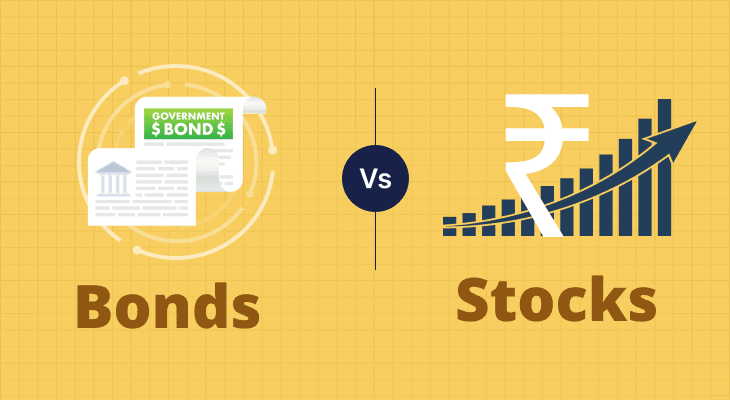
Bonds vs. Stocks: A Beginner’s Guide
Investing in financial markets can often become overwhelming due to the multiple options available, especially for beginners. Understanding the difference between stocks and bonds is crucial for making informed investment decisions. Both these financial instruments offer unique benefits and risks, and knowing their distinct characteristics can help you build a balanced and diversified portfolio. This guide will explore the fundamental aspects of the bond market versus the stock market, detail the differences between stocks, shares, and bonds, and help you determine which option might be best suited for your investment goals.
A Comparison of the Bond and Stock Markets
The bond market and the stock market are two primary components of the financial system. They facilitate the trading of securities and play vital roles in the economy. Understanding the differences between the bond market and the stock market is essential for investors seeking to diversify their portfolios and manage risk effectively. While both markets provide avenues for raising capital, they operate differently and cater to distinct types of investors.
The Stock Market
The stock market is where shares of publicly traded companies are bought and sold. When you purchase a stock, you buy a piece of ownership in a company. Stocks represent equity, meaning shareholders have a claim on a portion of the company’s assets and earnings. Unlike bonds, which provide fixed interest payments, stocks offer the potential for capital appreciation and dividends, which are not guaranteed.
The Bond Market
The bond market, also known as the debt market or credit market, is where investors buy and sell bonds. Bonds are essentially loans made by investors to corporations, municipalities, or governments. In return, the bond issuer promises to pay back the principal amount on a specified date (maturity date) along with periodic interest payments (coupon payments). There are several types of bonds, each with distinct characteristics:
Government Bonds:
Issued by national governments and considered low-risk due to the backing of the government.
Municipal Bonds:
Issued by local governments or municipalities, often offering tax-free interest payments.
Corporate Bonds:
Issued by companies to raise capital, typically offering higher yields than government bonds due to higher risk.
Zero-Coupon Bonds:
Sold at a discount and do not pay periodic interest; the return is the difference between the purchase price and the face value at maturity.
Where Bonds Are Traded?
Bonds can be traded in both primary and secondary markets:
Primary Market:
Where new bonds are issued and sold directly to investors, usually through underwriting by financial institutions.
Secondary Market:
Where existing bonds are traded among investors. The OTC market is the most common venue, involving direct transactions between parties. Bond exchanges like the NSE and the BSE also provide platforms for bond trading, offering more transparency and liquidity.
Who Participates in the Bond Market?
The bond market comprises various participants:
Individual Investors:
Individuals (retail) investors seeking stable income and preservation of capital can buy bonds directly or through bond funds.
Institutional Investors:
Institutional investors such as pension funds, insurance companies, and mutual funds, are significant players in the bonds market due to their large capital bases.
Government Entities:
Central and State Government agencies and departments frequently Issue bonds to finance public projects and manage national or regional debts.
Central Banks:
While neither a buyer or a seller, banks like the RBI, influence interest rates and liquidity, directly impacting bond prices and yields.
Commercial Banks:
Private and PSU banks buy and sell bonds to manage their investment portfolios and liquidity needs.
Key Differences
Understanding the key differences between stocks and bonds is fundamental to making informed investment choices. Here are some crucial aspects to consider:
Ownership vs. Debt:
Stocks represent ownership in a company, while bonds represent a loan made to the issuer. Stockholders are equity owners, whereas bondholders are creditors.
Returns:
Stocks have the potential for higher returns through capital gains and dividends, but they come with higher risk. Bonds provide regular interest payments and are generally considered safer, but they offer lower returns.
Risk:
Stocks are more volatile and can fluctuate significantly in value. Bonds are typically less volatile, providing more stable and predictable returns, especially government and high-quality corporate bonds.
Priority in Bankruptcy:
In the event of a company's bankruptcy, bondholders have a higher claim on assets than stockholders. Bondholders are paid before equity shareholders, making bonds a safer investment in this regard.
Maturity:
Bonds have a fixed maturity date when the principal amount is repaid. Stocks do not have a maturity date; you can hold them indefinitely or sell them at any time.
Income:
Bonds provide fixed interest payments at regular intervals. Stocks may offer dividends, but these payments are not guaranteed and can vary based on the company's performance.
Market Structure:
The bond market is primarily OTC, involving direct transactions between parties. The stock market operates through organised exchanges, offering more liquidity and transparency.
Which One to Select?
Now that you know the key differences between stocks and bonds, you must be wondering which financial instrument is right for you. Deciding between investing in stocks or bonds is a critical decision that depends on various factors including your financial goals, risk tolerance, investment horizon, and market conditions. Here are a few considerations to help you determine which might be the better option for your unique circumstances:
Assessing Your Financial Goals:
Your financial objectives play a significant role in determining whether to invest in stocks or bonds. If your primary goal is to build wealth over a long period, stocks might be more suitable due to their higher potential for capital appreciation. Stocks have historically provided higher returns compared to bonds, making them ideal for investors looking to grow their wealth.
On the other hand, if your objective is to preserve capital and generate steady income, bonds might be a better fit. Bonds offer fixed interest payments and return of principal at maturity, providing a predictable income stream and reducing the risk of capital loss. This makes them suitable for retirees or individuals approaching retirement who need stable income without significant risk.Evaluating Risk Tolerance:
Your risk tolerance is another crucial factor. Stocks are inherently more volatile than bonds, meaning their prices can fluctuate widely in a short period. If you have a high risk tolerance and can withstand short-term market fluctuations, investing in stocks might be appropriate. Stocks can offer significant returns, but they also come with the risk of substantial losses, especially in the short term.
Conversely, if you have a low risk tolerance and prefer stability and predictability, bonds are typically a safer investment. Bonds are less volatile and provide regular interest payments, making them less susceptible to market swings. Government bonds, in particular, are considered very safe, although corporate bonds carry higher risk and higher potential returns.Considering Investment Horizon:
Your investment horizon, or the length of time you plan to hold an investment, is critical in deciding between stocks and bonds. If you have a long-term investment horizon (10 years or more), stocks might be the better option. The longer you hold stocks, the more time you have to ride out market volatility and benefit from compound growth.
For short-term investment horizons (less than five years), bonds are generally preferable. The fixed income from bonds can provide stability and ensure that your capital is available when needed. Intermediate-term horizons (five to ten years) might benefit from a balanced approach, combining both stocks and bonds to manage risk and return effectively.Market Conditions and Economic Outlook:
Current market conditions and the economic outlook can also influence your decision. In a strong economy with rising corporate profits, stocks often perform well. In contrast, during economic downturns or periods of high interest rates, bonds might be a safer investment. It’s essential to consider the economic environment and market trends when making your investment choices.Diversification:
Many financial advisors recommend a diversified portfolio that includes both stocks and bonds. Diversification helps spread risk and can provide a more stable return over time. The proportion of stocks and bonds in your portfolio should align with your risk tolerance, financial goals, and investment horizon.
Case Scenarios
Young Professional:
A young professional in their 20s or 30s with a long investment horizon and a higher risk tolerance might invest 80% in stocks and 20% in bonds. This allocation takes advantage of the potential for higher returns from stocks while providing some stability through bonds.
Mid-Career Investor:
Someone in their 40s or 50s might shift to a more balanced approach, such as 60% in stocks and 40% in bonds, to reduce risk as they approach retirement while still aiming for growth.
Retiree:
A retiree or someone close to retirement might prefer a conservative allocation, such as 30% in stocks and 70% in bonds, prioritising capital preservation and income generation over growth.
Conclusion
Understanding the difference between stocks and bonds is essential for building a robust investment strategy. Stocks offer ownership and the potential for high returns but come with greater risk and volatility. Bonds provide more stable and predictable returns with lower risk but generally offer lower returns compared to stocks. By carefully considering your financial goals, risk tolerance, and investment horizon, you can decide the right mix of stocks and bonds to create a diversified and balanced portfolio. Investing in both asset classes can help mitigate risk and enhance returns, providing a solid foundation for achieving your financial objectives.
FAQ
What is the main difference between stocks and bonds?
The main difference between stocks and bonds lies in ownership and obligation. Stocks represent ownership in a company, giving shareholders a claim on part of the company’s assets and profits. Bonds, on the other hand, are a form of debt where investors loan money to an entity (corporation, government, etc.) in exchange for periodic interest payments and the return of principal at maturity. Stocks offer potential for high returns but come with higher risk, while bonds provide more stable returns with lower risk.
Which is riskier: stocks or bonds?
Stocks are generally riskier than bonds. Stock prices can be volatile and subject to market fluctuations, economic changes, and company performance. Bonds are considered safer investments because they offer fixed interest payments and the return of principal at maturity, making them less volatile. However, bondholders are exposed to interest rate risk and credit risk. Government bonds are typically safer than corporate bonds.
How do I decide whether to invest in stocks or bonds?
Deciding whether to invest in stocks or bonds depends on your financial goals, risk tolerance, and investment horizon. If you seek higher returns and can tolerate market volatility, stocks might be suitable. If you prefer stable income and lower risk, bonds are a better option. Many investors choose a balanced approach, diversifying their portfolios with both stocks and bonds to manage risk and return effectively.
Can I lose money investing in bonds?
Yes, it is possible to lose money investing in bonds. If you sell a bond before it matures for less than its purchase price, you may incur a loss. Additionally, if the issuer defaults on interest payments or principal repayment, bondholders can lose money. However, bonds are generally considered safer than stocks and offer more predictable returns.
How do interest rates affect bond prices?
Interest rates and bond prices have an inverse relationship. A rise in the interest rates usually leads to a fall in the prices of existing bonds. This is because new bonds are introduced providing a yield higher than the existing bonds, making them less attractive to new investors. Conversely, when interest rates decline, existing bond prices usually rise. Investors need to consider interest rate risk when investing in bonds.
What are the advantages of investing in stocks?
Investing in stocks offers several advantages, including potential for high returns, dividends, and capital appreciation. Stocks provide the opportunity to participate in the growth and profitability of companies. They also offer liquidity, as they can be easily bought and sold on stock exchanges. However, stocks come with higher risk compared to bonds.
What are the benefits of investing in bonds?
Bonds provide stable income through regular interest payments and return of principal at maturity, making them a good option for income-focused investors. They are less volatile than stocks and can help diversify an investment portfolio. Bonds are also considered safer, especially government bonds, and can preserve capital during market downturns.
How do stock dividends work?
Stock dividends are payments made by a company to its shareholders, usually derived from the company’s profits. Dividends are typically paid quarterly and can provide a steady income stream for investors. Not all stocks pay dividends; some companies reinvest profits back into the business. Dividends can be a significant component of the total return from stock investments.
What is the significance of bond ratings?
Bond ratings, provided by rating agencies like Moody’s, S&P, and Fitch, assess the creditworthiness of a bond issuer. High ratings (AAA, AA) indicate low risk of default, while lower ratings (BB, B, and below) indicate higher risk. Investors use bond ratings to gauge the risk associated with a bond and to make informed investment decisions. Higher-rated bonds typically offer lower yields, while lower-rated bonds offer higher yields to compensate for increased risk.
Can I have both stocks and bonds in my investment portfolio?
Yes, having both stocks and bonds in your investment portfolio is a common strategy known as diversification. Combining stocks and bonds helps balance risk and return, providing growth potential from stocks and stability from bonds. The proportion of stocks and bonds in your portfolio should align with your financial goals, risk tolerance, and investment horizon. A diversified portfolio can better withstand market fluctuations and achieve long-term financial objectives.


